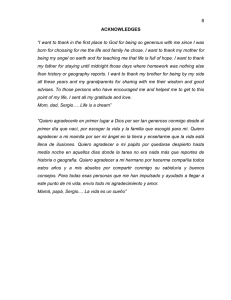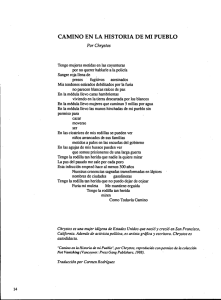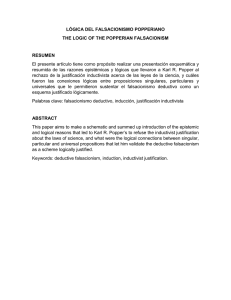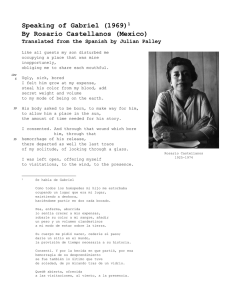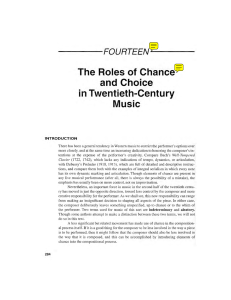Romancero Gitano (Lorca) Mario Castelnuovo
Anuncio
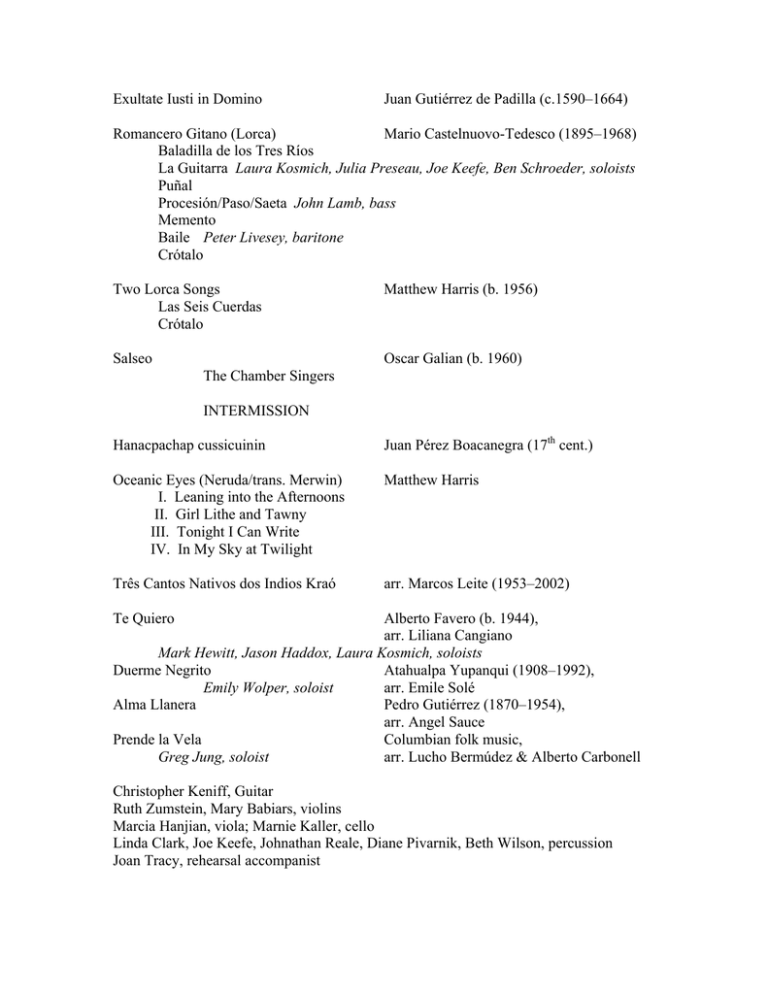
Exultate Iusti in Domino Juan Gutiérrez de Padilla (c.1590–1664) Romancero Gitano (Lorca) Mario Castelnuovo-Tedesco (1895–1968) Baladilla de los Tres Ríos La Guitarra Laura Kosmich, Julia Preseau, Joe Keefe, Ben Schroeder, soloists Puñal Procesión/Paso/Saeta John Lamb, bass Memento Baile Peter Livesey, baritone Crótalo Two Lorca Songs Las Seis Cuerdas Crótalo Matthew Harris (b. 1956) Salseo Oscar Galian (b. 1960) The Chamber Singers INTERMISSION Hanacpachap cussicuinin Juan Pérez Boacanegra (17th cent.) Oceanic Eyes (Neruda/trans. Merwin) I. Leaning into the Afternoons II. Girl Lithe and Tawny III. Tonight I Can Write IV. In My Sky at Twilight Matthew Harris Três Cantos Nativos dos Indios Kraó arr. Marcos Leite (1953–2002) Te Quiero Alberto Favero (b. 1944), arr. Liliana Cangiano Mark Hewitt, Jason Haddox, Laura Kosmich, soloists Duerme Negrito Atahualpa Yupanqui (1908–1992), Emily Wolper, soloist arr. Emile Solé Alma Llanera Pedro Gutiérrez (1870–1954), arr. Angel Sauce Prende la Vela Columbian folk music, Greg Jung, soloist arr. Lucho Bermúdez & Alberto Carbonell Christopher Keniff, Guitar Ruth Zumstein, Mary Babiars, violins Marcia Hanjian, viola; Marnie Kaller, cello Linda Clark, Joe Keefe, Johnathan Reale, Diane Pivarnik, Beth Wilson, percussion Joan Tracy, rehearsal accompanist This concert came about when guitarist Chris Keniff introduced me to the lush and seldom-performed Romancero Gitano, which is basically a guitar concerto with chorus. I thought the work, based on the works of the great Spanish poet Lorca, would pair well with the little-known Oceanic Eyes by Harris. Not only is Harris’ work also set to great Hispanic poetry (by the Chilean Neruda), but it also uses guitar (and string quartet). Then I discovered Harris’ Lorca Songs. Meanwhile, the Neruda aesthetic led me to explore more music from Latin America – everything from South American folk songs to baroque cathedral music. In the end, though, what draws the concert together is rhythm and passion. Every piece is a dance and every text draws you right to some emotional raw nerve. Surrender to it… Juan Gutiérrez de Padilla spent almost 40 years as music director for the Puebla Cathedral Choir in Mexico, composing glorious double choir motets. The completion and dedication of the cathedral structure in 1649 inspired some of his best work, including Exultate Iust in Domino. Exsultáte iusti in Dómino: rectos decet collaudátio. Confitémini Dómino in cíthera: in psaltério decem cordárum psállite illi. Cantáte ei cánticum novum; bene psállite ei in vociferatióne. Quia rectum est verbum Dómini; et ómnia ópera eius in fide. Díliget misericórdiam et iudícium: misericórdia Dómini plena est terra. Verbo Dómini caeli firmátisunt: et spíritus oris eius omins virtus eórum. Rejoice in the Lord, O ye righteous: for praise is comely for the upright. Praise the Lord with harp: sing unto him with psaltery and an instrument of ten strings. Sing unto him with a new song; play skillfully and with a loud noise. For the word of the Lord is right; and all his works are done in truth. He loveth righteousness and judgment: the earth is full of the goodness of the Lord. By the word of the Lord were the heavens made: and all the host of them by the breath of his mouth. Mario Castelnuovo-Tedesco was an Italian composer born in Tuscany in 1895. After completing a degree in piano, he studied with the renowned Italian composer Pizzetti, completing a composition degree in 1918, and then came to the attention of the pianist Alfredo Casella, who championed the young composer’s works. Great literature and his Jewish heritage were sources of inspiration. His Violin Concerto (1931) written at the request of Jascha Heifetz was an expression of “splendor of past days” in the face of rising anti-Semitism in Europe. At a 1932 Contemporary Music Festival in Venice, Castelnuovo-Tedesco met the famous Spanish guitarist Andres Segovia, for whom he wrote his Guitar Concerto No. 1, the first of nearly a hundred guitar compositions. By the following year, Italian fascist government policies began to treat the arts as propaganda for racist ideals and banned Castenuovo-Tedesco’s works from performance or broadcast. Sponsored by Toscanini, the composer left Italy for the U.S. in 1939, right before the outbreak of World War II. He settled first in Larchmont, New York, but soon ended up in Hollywood, where with the help of Heifetz, he landed a contract with MGM as a film composer. He contributed to over 200 films, but still found time to write concert music, and become Los Angeles’ most sought after composition teacher, with students including André Previn, John Williams, and Henry Mancini. His more than 200 opus numbers include many works for voices, piano, guitar, opera, ballet and chamber music. He never became as well-known as he deserved, probably because he was writing “tuneful” music in an era which regarded that with disdain, at least on the “serious classical” front. Now that we have rediscovered melody, perhaps it is time to rediscover Mario Castelnuovo-Tedesco. The composer had this to say: “I have never believed in modernism, or neoclassicism, or any other ‘isms’. I believe that music is a form of language capable of progress and renewal (and I myself believe that I have a feeling for the contemporary and, therefore, am sufficiently modern). Yet music should not discard what was contributed by preceding generations. Every means of expression can be useful and just, if it is used at the opportune moment (through necessity rather than through caprice or fashion). The simplest means are generally the best. I believe that my personality was formed to a decisive degree quite early, but what I have sought to do, during my artistic evolution, has been to express myself with means always simpler and more direct, in a language always cleaner and more precise.” Romancero Gitano, op. 152, was written in Los Angeles in 1951, basically as a concerto for guitar with chorus, based on the gripping poetry of Federico García Lorca (18981936). Most of the poems come from the 1921 collection called Poema del canto jondo, (Poem of the Deep Song), a title which refers to a type of flamenco singing. Lorca, considered Spain’s greatest modern poet and playwright, was from Andalucia. Influenced by flamenco and gypsy music, Lorca himself was a musician and composed music. He was good friends with Manuel de Falla and other composers. (Although not politically affiliated, his friendship with left-wing intellectuals and love of liberty led to his execution by a right-wing firing squad during the Spanish Civil War.) In the first movement “Baladilla de los Tres Ríos,” the guitar imitates the rushing water of the Guadalupe River, while appassionata solo flourishes interrupt the chorus. El Río Guadalquivir va entre naranjos y olivos. Los dos ríos de Granada bajan de la nieve al trigo. ¡Ay, amor que se fué y no vino! El Río Guadalquivir tiene las barbas granates. Los dos ríos de Granada, uno llanto y otro sangre. ¡Ay, amor que se fué por el aire! The Guadalquivir River runs through orange trees and olive trees. The two rivers of Granada descend from the snow to the wheat. O love that went away and didn’t come back! The Guadalquivir River has banks of garnets. The two rivers of Granada, one of tears and the other blood. O love that vanished into thin air! Para los barcos de vela Sevilla tiene un camino; por el agua de Granada solo reman los suspiros. Guadalquivir, alta torre y viento en los naranjales. Dauro y Genil, torrecillas muertas, sobre los estanqués. Quien dirá que el aqua lleva un fuego fatuo de gritos. Lleva azahar, lleva olives, Andalucía a tus mares. For sailing ships, Seville has a road; through Granada’s water row only sighs. Guadalquivir, high tower and wind in the orange groves. Dauro and Genil, dead little towers, above the ponds. Who can say if water brings forth a will-o’-wisp of screams? It carries orange blossoms, it carries olives, Andalucía, to your seas. In the second movement “La Guitarra,” the guitar sets the flamenco mood, as the instrument is compared to “heart wounded by 5 swordsmen” (i.e., the 5 strings of the guitar). Empieza el llanto de la guitarra. Se rompen las copas de la madrugada. Es inútil callarla. Es impossible callarla. Llora monotona, como llora el agua, como llora el viento sobre la nevada. Llora por cosas lejanas, como arena del sur caliente que pide camellias blancas. Llora flecha sin blanco, la tarde sin mañana, y el primer pájaro muerto sobre la rama. ¡O, Guitarra! Corazón malherido por cinco espadas. The lament of the guitar begins. The goblets of dawn are broken. It is useless to quiet it. It is impossible to quiet it. It cries monotonously, like the water cries, like the wind above the snowcaps cries. It cries for distant things, like the sand of that hot south that asks for white camellias. It cries like an arrow without target, like an evening without a morning, and like the first dead bird on the branch. O guitar! Heart wounded by five swordsmen (i.e. strings of the guitar). The third movement “Puñal” is the most dissonant and aggressive, as the dagger flashes. El puñal entre el corazón como la reja del arado en el yermo. ¡No, no, no me lo claves! El puñal entre el corazón como un rayo de sol incendia las terribles hondonadas. The dagger enters the heart like the blade of the plow in the barren wasteland. No, no, do not stab me with it! The dagger enters the heart like a ray of sun ignites the terrible hallows. ¡No, no, no me lo claves! No, no, do not stab me with it! The fourth movement combines 3 poems, “Procesión,” “Paso,” and “Saeta,” which follow logically. The bass soloist sets a dreamlike stage, followed by the floating procession song, which refers to, and leads into, the saeta, a type of Holy Week song in honor of the Virgin. 1. Procesión 1. Procession Por la calle vienen exstraños unicornios¿De qué campo? ¿De qué bosque mitológico? Más cerca y aparecen astrónomos, fantásticos Merlines y el Ecce Homo, Durandarte encantado Orlando furioso… Through the street come strange unicornsFrom which field? From what mythological wood? Closer, and they look like astronomers, fantastic Merlins and the Ecce Homo, the armored Durandarte, the mad Orlando… 2. Paso 2. Float Virgen con miriñaque Virgen de soledadabierta como un immenso tulipán. En tu barco de luces vas por la alta marea de la ciudad; ¡entre saetas turbias y estrellas de crystal, tú vas por el río de la calle Virgin with a hoopskirt, Virgin of solitudeopen like an immense tulip. In your boat of lights you sail on the high tide of the city; between turbid saetas and crystal stars, you float down the street hasta el mar! to the sea! 3. Saeta 3. Saeta (a type of Holy Week song) Cristo Moreno pasa de lirio de Judea a clavel de España. ¡Míralo por donde viene! ¡Míralo por donde va! De España. Cielo limpio y oscuro tierra tostada, y cauces donde corre muy lenta el agua. Cristo Moreno pasa con las guedejas quemadas, los pomulos salientes, The dark Christ passes from the lily of Judea to the carnation of Spain. Behold from where he comes! Behold whither he goes! From Spain. Clear, black sky, scorched earth, and the water runs very slowly. The dark Christ passes with burned locks of hair, protruding cheekbones, y las pupilas blancas. and blank eyes. “Memento” again refers to the guitar, in its sultry tango of death. Cuando yo me muera, enterrarme con mi guitarra, bajo la arena, entre los naranjos y la hierba buena. Cuando yo me muera, enterrarme si que réis en una veleta. When I die, bury me with my guitar, under the sand, among the orange trees and mint. When I die, bury me, if you wish, in a thin shroud. “Baile” is an elegant seguidilla in which the baritone describes Carmen’s dance through the streets of Seville, while the tenor solo interjections recall the first movement. La Carmen está bailando por las calles de Sevilla. Tiene blancos los cabellos y brillantes las pupilas. ¡Niñas, corred las cortinas! En su cabeza se enrosca una serpiente amarilla, y va soñado en el baile con galanes de otros días. Las calles están desiertas y en los fondos, corazónes Andaluces se adivinan, buscando viejas espinas. Carmen is dancing through the streets of Seville. Her hair is white and her eyes are shining. Children, draw the curtains! In her hair is coiled a yellow serpent, and she goes on dreaming in her dance with former lovers. The streets are deserted and in the background, Andalucían hearts are still guessing, looking for old suspicions. The final movement, “Crótalo,” marked “furioso,” is full of cross-rhythms and percussiveness to depict the text. Crótalo. Escarabajo sonoro. En la araña de la mano rizas el aire cálido, y te ahogas en tu trino de palo. Crótalo. Rattler. Sonorous beetle. In the spider of the hand, you ripple the warm air and drown in your trill of wood. Rattler. Composer Matthew Harris is one of Harmonium’s favorite local composers. We commissioned and premiered his major Christmas Oratorio, A Child’s Christmas in Wales, with text by Dylan Thomas, in 2002; the Harmonium men sang the New Jersey premiere of his Love Songs, and we have performed several of his books of Shakespeare Songs and O Sacrum Convivium both in concert and on tour. Matthew Harris was born 1956 in New York State, studied at The Juilliard School, New England Conservatory and Harvard University. His teachers include Elliott Carter, Milton Babbitt, Roger Sessions and Donald Martino. Mr. Harris has taught at Fordham University and Kingsborough College, CUNY. He lives in New York City, where he works as a musicologist. Mr. Harris received two grants in composition from the National Endowment for the Arts and fellowships from the New York Foundation for the Arts, Tanglewood, Composers Conference at Wellesley, Ives Center, Conductors Institute, and the MacDowell and Yaddo artist colonies. Prizes he won for his works include the Chautauqua Chamber Singers Choral Composition Contest, Georges Enesco International Composition Award and many others. The Minnesota Orchestra, Houston Symphony, and the Florida, Jacksonville, Chattanooga, Spokane, and Modesto Symphony Orchestras have played his orchestral works. His choral works have been performed by numerous choirs, including the Dale Warland Singers and the New Amsterdam Singers, who performed his music at the televised Three Tenors concert at the Meadowlands. Two Lorca Songs are settings from the same early collection of poems that CastelnuovoTedesco used, Poema del canto jondo, and both use the poem Crótalo. Mr. Harris provides the following notes: “My setting of Las Seis Cuerdas was inspired by the poem’s haunting melancholy. Sopranos and altos sing falling, weeping lines while underneath, basses and tenors have wide, guitar-like intervals. Crótalo, written for a choral competition, is meant to display choral virtuosity. It is set to a flamenco dance, the percussive ‘c’ and ‘t’ sounds from the repeated word ‘crótalo’ make a rhythmic clicking like that of castanets.” I. Las Seis Cuerdas La guitarra hace llorar a los sueños. El sollozo de las almas perdidas se escapa por su boca redonda. Y como la tarantula teje una gran estrella para cazar suspiros, que flotan en su negro aljibe de madera. I. The Six Strings The guitar makes dreams weep. The sobbing of lost souls escapes through its round mouth. And like the tarantula it spins a large star to trap the sighs floating in its black, wooden water tank. Salseo is an original composition by the contemporary Venezuelan composer Oscar Galian based on the traditional rhythm of the Caribbean salsa. The composer uses onomatopoetic sounds to create different rhythmic cells which imitate the traditional Latin American percussion instruments such as the bongos, congas, toc-toc and concerro (bell). Juan Pérez Boacanegra published Hanacpachap cussicuinin in Lima, Peru, in 1641, making it the first piece of polyphonic music published in the Western Hemisphere. The language is Quecha (Incan). The text celebrates the beauty of Mary as Queen of Flowers, and the pronounced rhythm suggests a processional. Hanacpachap cussicuinin. Huaran cacta muchascaiqui Yupairuru pucoc mallqui Runa cunap suyacuinin Callpan nacpa quemi cuinin Huac iascaita. O tree bearing thrice-blessed fruit, Heaven’s joy! a thousand times shall we praise you. O hope of humankind, helper of the weak. Hear our prayer! Uyarihuai muchascaita Diospa rampan Diospa maman Yurac tocto hamancaiman Yupascalla, collpascaita Huahuarquiman suyuscaita Ricuchillai. Attend to our pleas, O column of ivory, Mother of God! Beautiful iris, yellow and white, receive this song we offer you; come to our assistance, show us the Fruit of your womb! Written in 1997 by Matthew Harris, Oceanic Eyes was commissioned by the Jeffrey D. Silver Fund of I Cantori di New York, and is dedicated to their conductor, Mark Shapiro. It is a four-movement work for chorus, guitar and string quartet based on the early erotic poetry of Pablo Neruda, Veinte poemas de amor y una canción desesperada (Twenty Love Songs and a Song of Despair) (Chile, 1924). Although Neruda, like Picasso, was constantly reinventing himself, and became increasingly political and surrealist in his later works, it is these early intensely lyrical and sexual poems which remain his most famous. The translation by W. S. Merwin was published in 1969. In these poems, the woman is personified by nature. Harris stated: “I wanted to capture in my music the twenty-year-old poet’s over-sized emotions and fresh sensations. At the same time, I strove to mirror the poetry’s structural tautness and economy of means. I used the delicate sounds of guitar and string quartet to create an intimate atmosphere for the lovers.” The first movement. “Leaning into the Afternoons,” sets a sensual poem with long legato lines and expressive dissonances. Leaning into the afternoons I cast my sad nets towards your oceanic eyes. There in the highest blaze my solitude lengthens and flames, its arm turning like a drowning man’s. I send out red signals across your absent eyes that move like the sea near a lighthouse. You keep only darkness, my distant female. From your regard sometimes the coast of dread emerges. Leaning into the afternoons I fling my sad nets to that sea that beats on your oceanic eyes. The birds of the night peck at the first stars that flash like my soul when I love you. The night gallops on its shadowy mare shedding blue tassels over the land. The second movement, “Girl Lithe and Tawny,” is a joyful dance, and quotes the Rhinegold theme from Wagner’s Ring Cycle. Harris explains: “The girl in the water reminded me of the Rhinemaidens at the beginning of Rhinegold frolicking about. But I use a raised 4th in the ascending scales, giving it a little modal twinge.” Girl lithe and tawny, the sun that forms the fruits, that plumps the grains, that curls seaweeds filled your body with joy, and your luminous eyes and your mouth that has the smile of the water. A black yearning sun is braided into the strands of your black mane, when you stretch your arms. You play with the sun as with a little brook and it leaves two dark pools in your eyes. Girl lithe and tawny, nothing draws me towards you. Everything bears me farther away, as though you were noon. You are the frenzied youth of the bee, The drunkenness of the wave, the power of the wheat-ear. My sombre heart searches for you, nevertheless, and I love your joyful body, your slender and flowing voice. Dark butterfly, sweet and definitive like the wheat-field and the sun, the poppy and the water. “Tonight I Can Write” is based on the twentieth poem, in which love has died and the lover despairs both his loss, and the inadequacy of his words to express that loss. The sad, slow music is interrupted in the middle by a delirious dream-sequence. Tonight I can write the saddest lines. Write, for example, ‘The night is starry and the stars are blue and shiver in the distance.’ The night wind revolves in the sky and sings. Tonight I can write the saddest lines. I loved her, and sometimes she loved me too. Through nights like this one I held her in my arms. I kissed her again and again under the endless sky. She loved me, sometimes I loved her too. How could one not have loved her great still eyes. Tonight I can write the saddest lines. To think that I do not have her. To feel that I have lost her. To hear the immense night, still more immense without her. And the verse falls to the soul like dew to the pasture. What does it matter that my love could not keep her. The night is starry and she is not with me. This is all. In the distance someone is singing. My soul is not satisfied that it has lost her. My sight tries to find her as though to bring her closer. My heart looks for her, and she is not with me. The same night whitening the same trees. We of that time, are no longer the same. I no longer love her, that’s certain, but how I loved her. My voice tried to find the wind to touch her hearing. Another’s. She will be another’s. As she was before my kisses. Her voice, her bright body. Her infinite eyes. I no longer love her, that’s certain, but maybe I love her. Love is so short, forgetting is so long. Because through nights like this one I held her in my arms. My soul is not satisfied that it has lost her. Though this be the last pain that she makes me suffer and these the last verses that I write for her. The fourth movement does not set the “Song of Despair,” but “In My Sky at Twilight” from a happier time in the relationship. In my sky at twilight you are like a cloud and your form and colour are the way I love them. You are mine, mine, mine, woman with sweet lips and in your life my infinite dreams live. The lamp of my soul dyes your feet, My sour wine is sweeter on your lips, Oh reaper of my evening song, how solitary dreams believe you to be mine! You are mine, mine, I go shouting it to the afternoon’s wind, and the wind hauls on my widowed voice. Huntress of the depths of my eyes, your plunder stills your nocturnal regard as though it were water. You are taken in the net of my music, my love, and my nets of music are wide as the sky. My soul is born on the shore of your eyes of mourning. In your eyes of mourning the land of dreams begins. Earthsongs publishers do a great service in providing both music and program notes for multicultural repertoire. The following notes are provided by the editors. Composed in 1982, Três Cantos Nativos dos Indios Kraó is freely based on melodies sung by the Krao tribe – a group of native Brazilian Indians who live in the Xingu river area of the Amazonia forest of northwestern Brazil. The work is divided into three short sections, or cantos. Marcos Leite was well-known in Brazil as a conductor, composer, pianist and musical theater director, where he performed with some of the most important popular artists and arranged popular tunes for vocal groups. Leite founded, directed and arranged music for the vocal ensemble Garganta Profunda. He taught and directed a choir at the Conservatorio de Musica Popular de Curitiba. The meaning of the text is not known; it was treated by the composer as a group of phonemes. (Daniel Rufino Alfonso, Jr., Editor.) The next three pieces are edited by María Guinad, for the series Música de Latinoamérica. She explains: “This series of Latin American choral music will provide an opportunity for many choirs to get to know this music, and, through it, to discover our traditions, our rhythms, and our soul.” She says about Te Quiero: “Te Quiero is an original song from the Argentinian composer of popular music, Alberto Favero. He sets to music a moving poem of Mario Benedetti (b. 1920), one of the best known poets from Uruguay. Benedetti, whose works include a vast collection of poems, novels, and tales, always writes in a very clear and expressive manner. His solidarity with the Latin American people and the sincerity with which he expresses the social, political, and economic problems of the continent have won him world-wide recognition. The music of Alberto Favero is vivid and expressive, particularly in the setting of this poem, where melody and text achieve a perfect unity. The choral arrangement by Liliana Cangiano, one of the most talented choral arrangers of popular songs in Argentina, gives new dimension to this work.” Si te quiero es porque sos mi amor, mi cómplice y todo y en la calle codo a codo somos mucho más que dos. If I adore you it is because you are my love, my intimate friend, my all; and in the street, arm in arm, we are so much more than two. Tus manos son mi caricia, mis acordes cotidianos te quiero porque tus manos trabajan por la justicia. Your hands are my caress, my daily affirmations. I love you because your hands work for justice. Tus ojos son mi conjuro contra la mala jornada te quiero por tu mirada que mira y siembra futuro. Your eyes are my lucky charm against misfortune. I adore you for your gaze that looks to and creates the future. Tu boca que es tuya y mía, tu boca no se equivoca; te quiero porque tu boca sabe gritar rebeldía. Your mouth is yours and mine, your mouth is never mistaken: I love you because your mouth knows how to cry out for rebellion. Y por tu rostro sincero y tu paso vagabundo y tu llanto por el mundo porque sos pueblo te quiero. And for your sincere face and wandering spirit and your weeping for the world-because you are the people, I love you. Y porque amor no es aureola ni cándida moraleja y porque somos pareja que sabe que no está sola. And because our love is neither famous nor naive, and because we are a couple that knows we are not alone. Te quiero en mi paraíso, es decir que en mi país la gente viva feliz aunque no tenga permiso. I want you in my paradise, which is to say, in my country; (I want) the people to live happily Even though they aren’t allowed to! Guinad provides the following information for Duerme Negrito and Alma Llanera: “In this lullaby composed by Atahualpa Yupanqui, one of the most popular Latin American composers of the 1960s and early 70s, the little black child is given impossible promises and warned of dire consequences, while the sad plight of the sick, hard-working mother is depicted in word and song. According to our translator, Carlos Lopez, ‘negrito’ literally means ‘little black one,’ or in modern usage, simply ‘darling,’ or ‘dear little one.’ But the words and text leave no doubt about the setting of this ‘black’ lullaby. The omission of some consonants all reflects the black Spanish pronunciation of the slave culture. The references to the brutal practice of cutting a person’s foot off to prevent escape and the sick mother working hard in the field and not getting paid can only be understood in terms of the dehumanizing conditions slaves endured for centuries in the New World.” Duerme, duerme negrito, que tu mama e’ta en el campo negrito. Drume, drume mobila. Sleep, sleep little black one, your mama’s in the fields, little one. Sleep, sleep little one. Te va a traé’ codonise para tí Te va a traé’ fruta fre’ca para tí Te va a traé’ ca’ne de ce’do para tí Te va a traé’ mucha’ cosa’ para tí. She’s going to bring quail for you, she’s going to bring fresh fruit for you, she’s going to bring pork for you, she’s going to bring many things for you. Y si negro no se duerme, viene e’ diablo blanco y zás le come la patica chica bú, apura chica bú. And if the black one doesn’t go to sleep, the white devil will come and zap! he’ll eat your little foot, chica bú; hurry, chica bú! Duerme, duerme negrito, que tu mama e’ta en el campo negrito. Sleep, sleep little black one, your mama’s in the fields, little one. Trabajando duramente, trabajando si, trabajando y no le pagan, trabajando si, trabajando y va tosiendo, trabajando si, p’al negrito chiquitito, p’al negrito si. She’s working hard, working, yes, working and they don’t pay her working, yes, working and she’s coughing, working, yes, for her sweet little black one, for her little black one, yes. The Alma Llanera (Soul of the Plains) of Pedro Elías Gutiérrez (1870-1954) is one of the most popular Venezuelan songs. Gutiérrez was mainly a composer of light music, particularly waltzes and zarzuelas. Alma Llanera, which belongs to a zarzuela of the same name, became so popular that it is considered a second national anthem by the Venezuelan people. It is a joropo, a typical Venezuelan dance rhythm based on the simultaneous combination of 3/4 and 6/8 meter. Because of its joyous character, it is usually performed during celebrations accompanied by the cuatro, a diatonic harp, and maracas. This choral arrangement by Angel Sauce, one of the most important Venezuelan conductors and composers of the 50's and 60's, contains the rhythmic elements in the tenor and bass. Yo nací en una ribera del Arauca vibrador. Soy hermana de las flores, soy hermana de las rosas, soy hermana de la espuma, de las garzas, de las rosas y del sol. I was born on a bank of the Arauca rapids. I am sister of the flowers, I am sister of the roses, I am sister of the foam, of the egrets, of the roses and the sun. Me arrulló la viva diana de la brisa en el palmar Y por eso tengo el alma como el alma primorosa del cristal. The lively reveille of the breeze serenaded me in the palm grove and therefore I have a soul like the exquisite soul of crystal. Amo, lloro, canto, sueño con claveles de pasion para ornar las rubias crines del potro de mi amador. I love, I cry, I sing, I dream about carnations of passion to adorn the blond mane of the colt of my beloved. The first to transcribe the traditional rhythms of Colombia for orchestra, Lucho Bermúdez (born: Luis Eduardo Bermúdez Acosta) had a profound effect on the music of Latin America. His group, Orquesta de Lucho Bermúdez, formed in 1946, remains one of the most celebrated dance bands in Colombia, continuing to perform at Club San Fernando, the Granada Hotel in Bagota, and the Rustic Club in Medellin. Bermúdez's musical talents were obvious from earliest childhood. Taught basic music theory at the age of seven by his uncle, Jose Maria Montes, he mastered flute, clarinet, trombone, and trumpet within three years. Accepting a position as arranger and director of Banda Papayera at the age of 15, he formed his first orchestra, Orchestra of the Caribbean, by his 22nd birthday. After recording in Buenos Aires in 1946, Bermúdez returned to Colombia and formed Orquesta de Lucho Bermúdez. (Craig Harris, All Music Guide) After a free opening section, William Belan sets Prende la Vela in the style of a mapalé, a traditional dance brought to Cartagena, Colombia more than 400 years ago by slaves from Guinea. A couples’ dance, it is characterized by frenetic and erotic movements comprised of a succession of jumps, falls, pursuits and mock confrontations between the dancers. Mapalé is also the name of a fish. Legend has it that fishermen used to dance after a good fishing day, and that the movements of the dance represent the movements of a fish out of water. ¡Negrita, ven! Prende la vela. Come, my sweetheart! Light the candle. Prende la vela, mi negra, que va a empezá la cumbia en Marbella, cerca del mar y de las estrellas. Light the candle, my sweetheart, because the cumbia is starting in Marbella close to the sea and the stars. Prende la vela que la cumbiamba pide candela. Light the candle, because to dance the cumbia we need some candlelight.


